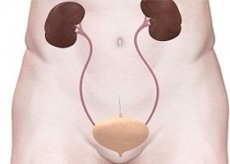Medical expert of the article
New publications
Tumors of the renal pelvis and ureter
Last reviewed: 04.07.2025

All iLive content is medically reviewed or fact checked to ensure as much factual accuracy as possible.
We have strict sourcing guidelines and only link to reputable media sites, academic research institutions and, whenever possible, medically peer reviewed studies. Note that the numbers in parentheses ([1], [2], etc.) are clickable links to these studies.
If you feel that any of our content is inaccurate, out-of-date, or otherwise questionable, please select it and press Ctrl + Enter.

Urothelial tumors of the renal pelvis and ureter are relatively rare. Tumors of the renal pelvis account for 10% of all renal neoplasms and 5% of all urothelial tumors. Tumors of the ureter are 4 times less common than tumors of the renal pelvis.
Epidemiology
Most often, men suffer from this disease, with a male-to-female ratio of 3:1. More often, neoplasms of this group develop in people of the Caucasian race compared to the Negroid race (ratio 2:1).
An increase in the incidence of renal pelvis and ureter cancer by 100-200 times is noted in individuals suffering from Balkan nephropathy, a degenerative interstitial nephritis of unknown etiology, most often found in the Balkans.
Upper urinary tract tumors associated with this disease are typically well-differentiated, multiple, and bilateral.
Causes tumors of the renal pelvis and ureter
Smoking is a risk factor that increases the risk of developing transitional cell carcinoma of the upper urinary tract by 3 times. About 70% of men and 40% of women who develop the disease are smokers.
Drinking more than seven cups of coffee per day is associated with an increased risk of developing the disease. Analgesics also increase the risk of urothelial cancer. There is an independent synergistic relationship between upper urinary tract tumors and papillary necrosis. Long-term use of analgesics induces nephropathy, which is associated with a high incidence of urothelial cancer, reaching 70%. In turn, the pathognomonic sign of analgesic use - capillary sclerosis - is found in 15% of patients with tumors of the renal pelvis and ureter.
Forms
TNM classification
T - primary tumor.
- Tis - Carcinoma in situ.
- Ta is a superficial/papillary tumor.
- T1 - invasion of the muscularis propria of the mucous membrane.
- T2 - invasion of the muscular layer of the organ wall.
- T3 - invasion into the peripelvic/periureteral tissue or renal parenchyma.
- T4 - involvement of adjacent organs.
N - regional lymph nodes.
- N0 - no metastases to regional lymph nodes.
- N1 - metastasis to one lymph node less than 2 cm in greatest dimension.
- N2 - metastasis 2-5 cm in greatest dimension in one lymph node or metastasis in several lymph nodes less than 5 cm in greatest dimension.
- N3 - metastasis in one lymph node more than 5 cm in greatest dimension.
M - distant metastases.
- M0 - no distant metastases.
- Ml - distant metastases.
 [ 11 ]
[ 11 ]
What do need to examine?
How to examine?
What tests are needed?
Who to contact?
Treatment tumors of the renal pelvis and ureter
Surgical treatment of tumors of the renal pelvis and ureter is indicated for localized and locally advanced tumors of the upper urinary tract. The standard approach to this category of neoplasms is nephroureterectomy.
Open nephroureterectomy is performed via a transperitoneal approach, removing the kidney, ureter, and part of the bladder surrounding the orifice. Regional lymph node dissection for upper urinary tract tumors allows for adequate assessment of the N category and has a potential therapeutic effect in patients with lymph node metastases.
Forecast
Five-year overall survival of patients with upper urinary tract cancer at stages Tis, Ta, T1 is 91%, T2 - 43%. At stages T3 - 4 and/or N1-2 - 23%, at stages N3/M1 - 0%. For tumors G1-2, the type of surgical intervention does not affect survival. However, the effectiveness of organ-preserving treatment of low-differentiated urothelial cancer is inferior to nephroureterectomy.

